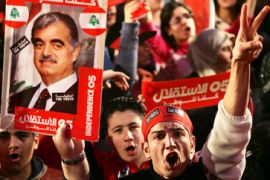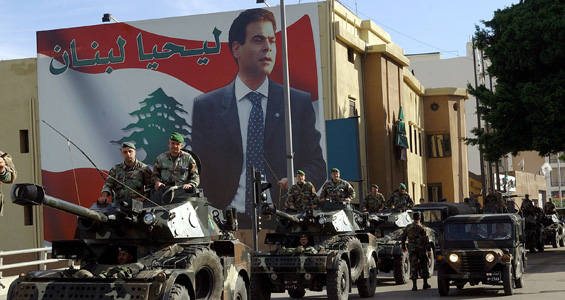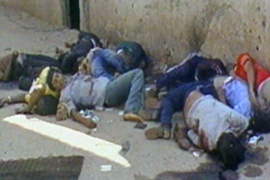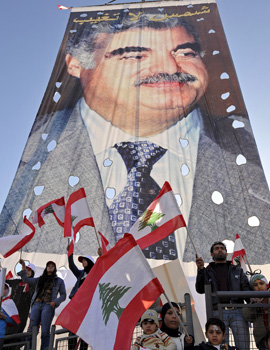Timeline: Lebanon
A chronology of key events in Lebanese history.

 |
| Pierre Gamayel [pictured] was assassinated late 2007 following a series of political killings [EPA] |
A chronology of key events in Lebanese history:
1920
September 1 – The state of Greater Lebanon is created after France is granted a mandate for Lebanon and Syria by the League of Nations.
Greater Lebanon includes the former autonomous province of Mount Lebanon – historically a stronghold of Maronite Christians and Druze Muslims – as well as the Syrian provinces of north Lebanon, south Lebanon and the Bekaa.
| In depth | ||
IN VIDEO INTERACT |
Britain holds the mandate for Palestine.
1926
May 23 – The Lebanese Republic is declared after approval of a constitution by the Lebanese Representative Council.
1932
A national census is held – the only official census in Lebanon’s history. It shows the Maronite Christian community as being the largest sectarian group, with Sunni Muslims next-largest, then Shia Muslims. Greek Orthodox comprise the fourth-largest, and Druze Muslims are the fifth-largest.
1940
The Vichy government of France assumes control of Lebanon.
1941
Free French and British troops invade Lebanon and Beirut is captured from Vichy forces. France promises to grant Lebanon independence.
1943
The 1932 census figures are used to determine the distribution of seats in the Chamber of Deputies, on a ratio of six Maronite Christians to five Muslims.
The highest political posts are also distributed along sectarian lines. The president is to be a Maronite Christian, the prime minister a Sunni Muslim, and the house speaker a Shia Muslim.
November-December – Free French forces hold members of the Lebanese government after they declare an end to the mandate. They are released on November 22, which is later known as independence day.
1944
January 1 – France transfers power to the Lebanese government.
1948
The state of Israel is created. Israel-Palestine war results in the exodus of thousands of Palestinians into Lebanon and Jordan.
1957
Camille Chamoun, Lebanon’s president, accepts the Eisenhower Doctrine. The doctrine offers US economic and military aid to countries in an effort to counteract Soviet global influence.
1958
Muslims rally to pan-Arab calls of Gamal Abdel Nasser, president of Egypt.
July 14 – Camille Chamoun, Lebanon’s president, appeals to the US to send troops.
July 15 – US marines land in Beirut to re-establish the authority of the Lebanese government.
1968
 |
| Yasser Arafat, who died in 2004, moved the PLO headquarters to Beirut in 1970 [AFP] |
December 28 – Israel launches air raid on Beirut airport in response to an attack by the Popular Front for the Liberation of Palestine (PFLP) on an Israeli aircraft in Athens. Thirteen civilian aircraft are destroyed.
1969
November – Emile Bustani, Israel’s army commander-in-chief and Yasser Arafat, chairman of the Palestine Liberation Organisation (PLO), sign an agreement in Cairo which aims to stop Palestinian fighters from launching operations from Lebanon.
1970
The PLO sets up its headquarters in Beirut after being driven out of Jordan. PLO raids from southern Lebanon increase.
1973
April 10 – Israel launches commando raid into Beirut. Three Palestinian leaders are killed.
April 11 – Lebanese government resigns.
1975
April 13 – Christian Phalange fighters ambush a bus in Ain-al-Rumannah, Beirut, killing 27 passengers. Most of those killed are Palestinian. The Phalangists claim Palestinian fighters had previously attacked a church in the same area. The ambush is generally regarded as the spark which ignited Lebanon’s civil war.
December – In an event later described as Black Saturday, four Christians are found shot dead in east Beirut. Bashir Gemayel, the leader of the Phalange militia, orders reprisals. Around 40 Muslim men are stopped at Christian roadblocks and murdered. Muslim militias retaliate in a similar fashion. By the end of the day, about 300 Muslims and 300 Christians have been murdered.
1976
Civil war intensifies. Christians kill Palestinian civilians at Karantina and Tel el-Zaatar, while Palestinians kill Christians at Damour.
June – Suleiman Franjieh, Lebanon’s president, invites Syria to intervene in the war. As the Muslim-left alliance in Lebanon gains an upper hand in the fighting, Hafez al-Assad, Syria’s president, orders troops into Lebanon.
Syrian troops occupy all but the far south of the country.
October – A ceasefire is agreed following Arab summit meetings. A mainly Syrian Arab Deterrent Force (ADF) is set up to maintain the ceasefire.
1978
March 14/15 – Israel invades Lebanon after PLO fighters launch an attack into its territory. Israeli troops push up as far the Litani river, approximately 40km north of the Israel-Lebanon border.
March 19 – United Nations Security Council resolution 425 is passed. It calls on Israel to withdraw from all Lebanese territory and establishes the United Nations Interim Force in Lebanon (Unifil) to oversee the withdrawal. Unifil is also charged with the responsibility of restoring peace and Lebanese government authority over south Lebanon.
Instead of handing south Lebanon to Unifil control, Israel passes control of the land to its proxy army, the pro-Christian South Lebanon Army (SLA).
1980-1
Clashes continue between Israel, Israel-backed fighters and the PLO in south Lebanon.
1982
June 6 – Israeli army launches Operation Peace for Galilee invasion in response to attempted assassination of Israeli ambassador to London.
Over the following weeks Israeli troops attack Syrian forces in Lebanon’s eastern Bekaa Valley, and surround Muslim west Beirut. Israel demands that PLO fighters and Syrians leave Beirut.
September – PLO forces evacuate Lebanon, under the supervision of US-French-Italian forces. Yasser Arafat, the organisation’s leader, leaves Beirut for Tunisia.
 |
| Around 800 refugees were killed during the 1982 Sabra and Shatila massacre |
September 14 – Bashir Gemayel, leader of the Christian Phalange militia and Lebanon’s president-elect, is assassinated.
September 15 – Israeli forces occupy west Beirut.
September 16-18 – In reprisal for the assassination of Gemayel, Phalangist militia massacre hundreds of Palestinians in the Sabra and Shatila refugee camps in southwest Beirut.
September 21 – Bashir Gemayel’s elder brother, Amin Gemayel, is elected president.
September 24 – A US-French-Italian multinational force, requested by Lebanon, arrives in Beirut.
1983
April 18 – A suicide bomber detonates an explosives-laden lorry drives into the US embassy on Beirut’s seafront. Sixty-three people are killed and more than 100 are hurt. Islamic Jihad claims responsibility.
May 17 – Israel and Lebanon sign a peace agreement in Naquora on condition Israel that withdraws from Lebanon.
September – US warships shell Muslim areas of Beirut in support of Amin Gemayel’s government.
October 23 – At least 241 US Marines and 58 French paratroopers are killed in an Islamic Jihad suicide lorry-bomb attack on the US Marine base in Beirut.
1984
Multinational force leaves Beirut after Lebanese government falls.
Several westerners are abducted in Beirut, including William Buckley, station chief for the US Central Intelligence Agency (CIA).
1985
By June 6 most Israeli troops withdraw. Some Israeli troops remain in support of proxy SLA.
SLA maintains a so-called security zone in south Lebanon.
May 19 – Afwaj al-Muqawama al-Lubnaniya (Amal), a Shia militia group, begins shelling Palestinian refugee camps in south Beirut.
June 16 – A passenger aircraft is hijacked by two alleged members of Hezbollah, an armed Shia organisation. The hijackers demand the release of Shia Muslims in Israeli jails. Syrian mediation resolves the crisis.
Several more Westerners, including Terry Anderson, a journalist for the Associated Press news agency, are seized.
1986
Amal continues attacks on Palestinian camps. Abductions of Westerners continue.
1987
January – Terry Waite, special envoy to the Archbishop of Canterbury, disappears in west Beirut while seeking the release of other Western hostages.
May 21 – Lebanon cancels 1969 Cairo agreement with the PLO, and also abrogates the May 17 1983 agreement with Israel.
June 1 – Salim al-Hoss becomes acting prime minister after Rashid Karami is killed in a bomb attack.
1988
 |
| Refugees in camps across Lebanon have been attacked by various factions [ITN] |
September 22 – Lebanese parliament fails to elect a successor to Amin Gemayel, Lebanon’s prime minister. Gemayel appoints a six-member interim military government, comprising three Christians and three Muslims.
Lebanon now has two governments – Salim al-Hoss heads the Muslim government in west Beirut while General Michel Aoun, the Maronite commander-in-chief of the Lebanese Army, controls east Beirut.
1989
March 14 – Michel Aoun declares war on Syrian army in Lebanon. Syrian forces, backed by their Lebanese militia allies, respond by besieging east Beirut. Aoun backs down.
October 22 – Lebanon’s National Assembly meets in Taif, Saudi Arabia. A Document of National Reconciliation is drawn up, which transfers executive power from the president to the cabinet. The previous 6:5 ratio of Christian to Muslims seats in the assembly is adjusted so that an equal balance between members is achieved.
1990
October 13 – Syrian air attacks force Michel Aoun from the presidential palace at Ba’abda.
The Lebanese civil war ends.
December 24 – Omar Karami heads a government of ‘national reconciliation’.
1991
The national assembly order that all militias be dissolved by April 30. The assembly permits Hezbollah to remain active. The SLA refuses to disarm.
May 22 – A Treaty of Brotherhood, Co-operation and Co-ordination is signed in Damascus by Lebanon and Syria.
July 1 – The Lebanese army defeats the PLO in Sidon. The army now faces the SLA and the Israelis in Jezzine, just north of the SLA’s so-called security zone.
August 26 – The national assembly grants amnesty for all crimes committed during the civil war. Aoun gets a presidential pardon and heads for exile in France.
1992
February 16 – Sheikh Abbas al-Moussawi, Hezbollah’s secretary-general, is killed when Israeli helicopter shoot at his motorcade near the town of Sidon.
By 17 June, all Western hostages have been released.
August-September – the first elections since 1972 take place in Lebanon.
October 20 – Nabih Berri, leader of Amal, becomes house speaker of the national assembly.
October 31 – Rafiq al-Hariri, a businessman with involvement in reconstruction and real estate, become prime minister.
1993
July 25 – Israel launches Operation Accountability in south Lebanon, in an attempt to crush Hezbollah and the Popular Front for the Liberation of Palestine-General Command (PFLP-GC).
1996
April 11 – Israel launches Operation Grapes of Wrath, bombing Hezbollah bases in southern Lebanon, south Beirut and the Bekaa.
April 18 – Israel shells a UN compound at Qana where Lebanese civilians are seeking cover from the bombing – 106 people die in the attack.
April 26 – A memorandum of understanding is reached, under which Hezbollah and Palestinian fighters agree not to attack civilians in northern Israel, in return for Hezbollah’s right to resist Israel’s occupation of southern Lebanon.
1998
April 1 – Israel’s inner cabinet votes to accept United Nations Security Council resolution 425 of 1978 in return for Lebanese guarantees of security along Israel’s northern border. Lebanon and Syria reject the proposal.
November 24 – Emile Lahoud, head of the Lebanese army, is sworn in as president.
December 4 – Salim al-Hoss becomes prime minister.
1999
June 3 – The SLA withdraws from Jezzine, a town north of the ‘security zone’. It had occupied Jezzine since 1985.
2000
April 18 – Israel releases 13 Lebanese prisoners held without trial for over a decade. It extends the detention of two other prisoners.
May 24 – Israel withdraws its forces from south Lebanon after the collapse of its proxy South Lebanon Army.
May 25 – An annual public holiday – Resistance and Liberation Day – is announced.
October – Rafiq al-Hariri becomes prime minister of Lebanon for the second time.
2001
March – Lebanon starts pumping water from a tributary of the River Jordan to a village on the Lebanon-Israel border. Israel opposes the move.
2002
January – Elie Hobeika, intelligence chief of the right-wing Christian Lebanese Forces militia at the time of the massacres of Palestinians at Sabra and Chatila, is killed in a car bomb blast in Beirut. The blast comes after Hobeika claimed he held tapes and documents challenging Israel’s account of the massacres.
September – Israel criticises a Lebanese plan to divert water from the Wazzani river on the Lebanon-Israel border, and threatens military force.
2003
August – Ali Hussein Saleh, a member of Hezbollah, is killed when a bomb explodes in his car in Beirut. Hezbollah and a government minister blame Israel for the attack.
2004
September – United Nations Security Council resolution 1559 is passed. The resolution calls for the exit of all foreign forces from Lebanon. It is aimed at Syria, whose troops and security personnel remain in the country. The resolution also calls for the disarmament of all Lebanese and non-Lebanese militia.
Parliament extends the presidential mandate of Emile Lahoud by three years. Rafiq al-Hariri, who opposed the extension of Lahoud’s term – resigns as prime minister.
2005
February 14 – Rafiq al-Hariri is killed in a car bomb blast in Beirut. Twenty-one other people die in the blast, including Basil Fleihan, former economy minister.
March 8 – A Hezbollah-organised rally takes place in Beirut, demonstrating support for Syria in answer to widespread anti-Syrian sentiment across Lebanon.
 |
| Rafik al-Harriri’s assassination sparked what became known as the Cedar Revolution [EPA] |
March 14 – Thousands of people attend a rally at Martyr’s Square in Beirut, demanding ‘the truth’ regarding Hariri’s assassination and calling for an end to Syria’s presence in Lebanon.
April – Omar Karami, the pro-Syrian prime minister, resigns after failing to form a government. Najib Mikati succeeds him.
Syria withdraws its forces from Lebanon, in line with UN Security Council resolution 1559.
June 2 – Samir Kassir, a journalist and critic of Syrian influence, is killed by a car bomb in Beirut.
The March 14 Forces, an alliance led by Saad al-Hariri, son of assassinated Rafiq al-Hariri, wins control of parliament after elections. The new parliament chooses Fouad Siniora, a former minister of finance, as prime minister.
June 21- George Hawi, anti-Syrian former leader of the Lebanese Communist Party, is killed in a car bomb blast.
July – Fouad Sinora, Lebanon’s prime minister, meets Bashar al-Assad, president of Syria. Both countries pledge to rebuild relations.
July 12: Elias Murr, Lebanon’s defence minister, is wounded in a car bombing in a northeast Beirut suburb. One person is killed and nine others are wounded.
September – Four pro-Syrian generals are charged over the assassination of Rafiq al-Hariri.
September 25: May Chidiac, a journalist, is badly wounded by a bomb placed in her car in north Beirut.
December 12 – Gibran Tueni, an MP and editor of the An-Nahar newspaper, is killed in a car bomb in Beirut. Two other people are killed.
2006
February – Demonstrations take place in Beirut in the wake of the publication of cartoons satirising Prophet Muhammad in a Danish newspaper. Denmark’s embassy in Beirut is set on fire.
July – The Islamic Resistance, Hezbollah’s armed wing, captures two Israeli soldiers in a cross-border raid.
Israel launches air- and sea-based attacks on targets in Lebanon. Hundreds of Lebanese civilians are killed and thousands are displaced. Hezbollah launches rockets into northern Israel, killing Israeli civilians.
August – Israeli ground troops enter south Lebanon.
August 14 – A truce between Hezbollah and Israel comes into effect. It brings an end to 34 days of fighting. More than 1,000 Lebanese – mostly civilians – have died, while 159 Israelis – most of them soldiers – have also been killed. Unifil2, a UN peacekeeping force with an expanded mandate, begins to deploy along the Lebanon-Israel border.
September – For the first time in decades, the Lebanese state army begins to deploy its forces along the southern border with Israel.
September 5: Lieutenant-Colonel Samir Shehadeh, an official linked to the inquiry into the Hariri murder, is wounded and four of his bodyguards killed in a blast in south Beirut.
November 21: Pierre Gemayel, Lebanon’s industry minister, and his bodyguard are shot dead in Jdeideh, north of the capital.
December 1 – Hezbollah, Amal and supporters of Michel Aoun, a Christian leader, camp outside the office of Fouad Siniora, the prime minister, in Beirut in an open-ended campaign to topple the government.
2007
January 25 – Aid conference in Paris pledges more than $7.5bn to help Lebanon recover from its 2006 war with Israel.
June 13: Walid Eido, a Sunni MP of the ruling March 14 coalition, is killed a car bomb blast on Beirut’s seafront. Eido’s eldest son Khaled, two bodyguards and six other people are also killed.
September 2 – Lebanese troops seize complete control of Nahr al-Bared camp near the northern city of Tripoli after months of fighting with Fatah al-Islam fighters. More than 420 people, including 168 soldiers, are killed.
September 19: Antoine Ghanem, an MP from the March 14 bloc is killed by a car bomb blast in the Beirut suburb of Sin el-Fil. Five other people, including two of his bodyguards, are killed and more than 50 others are wounded.
November 23 – Emile Lahoud leaves the presidential palace at end of his term without a successor having been elected. The next day, Siniora says his cabinet is assuming executive powers.
December 5 – Nabih Berri, the parliament speaker, says rival Lebanese leaders have agreed on General Michel Sleiman as president, although parliament has yet to elect him.
December 12: A car bomb attack near Beirut kills Brigadier-General Francois al-Hajj and three others, wounding at least seven others.
2008
January 15 – Car bomb in Christian area of Beirut kills at least three people and wounds 16, damages a US embassy car and destroys others.
January 25: Captain Wissam Eid, who was investigating leads on previous assassinations in Lebanon, is killed in a car bomb blast in a Beirut suburb.
 |
| Hezbollah, led by Hassan Nasrallah, used armed fighters internally in May 2008 [GALLO/GETTY] |
February 12: Imad Moghaniyah, a senior member of Hezbollah’s military and security apparatus, is killed in a car bomb attack in Damascus, the Syrian capital. Hezbollah blames Israel for the attack. Tel Aviv denies involvement.
April 20 – In the Christian town of Zahle, two local officials of the Christian Phalange party, a member of the ruling anti-Syrian coalition, are killed.
April 22 – Parliament fails to hold a session to elect a president, the 18th time it has been unable to hold a vote.
May 6 – Tension between the government and Hezbollah escalates after the cabinet calls the group’s communication network a threat to the country’s sovereignty.
Hezbollah says it is infuriated by government allegations it had spied on Beirut airport and by the cabinet’s decision to fire the head of airport security, who was close to the opposition.
May 7 – About 10 people are wounded as government supporters clash with fighters loyal to the Hezbollah-led opposition in Beirut, who had locked down the capital.
May 8 – Hassan Nasrallah, Hezbollah’s leader, says the government’s decision to dismantle his group’s communication network is an act of aggression.
Gun battles break out in Beirut, leaving several dead and many wounded.
An offer by Saad al-Hariri, the governing coalition leader, to refer the issue to the army, which has stayed neutral, is rejected by Hezbollah.
May 9 – Opposition forces seize control of west Beirut.
May 10 – Fouad Siniora, Lebanon’s prime minister, declares that the government will never declare war on Hezbollah but says the Shia group is trying to stage a coup.
The army rescinds the government’s demands, saying it will reinstate Beirut airport’s head of security and handle the issue of the Hezbollah’s communication network.
The army also calls on the opposition to withdraw its fighters from the streets.
Hezbollah and other groups allied to the opposition begin to pull their forces from Beirut’s streets. The army take over in a neutral security role.
May 10-11 – Pro and anti-government fighters clash overnight in the northern city of Tripoli. The Lebanese army is deployed to restore calm.
May 21 – Government and opposition representatives reach a power-sharing agreement after five days of talks in Qatar.
The Hezbollah-led opposition wins a greater share of seats in the cabinet, giving it an effective veto over any decisions reached by the executive.
Electoral districts in the capital are also recomposed in an effort to make them more representative.
May 25 – Sleiman is elected the new president in line with the Doha pact.
May 28 – Sleiman reappoints Siniora as prime minister at the head of a new unity government.
June 18 – Three people are killed and four others wounded in clashes between pro and anti-government supporters in the Bekaa valley.
June 22 – One person is killed and at least 24 are injured after heavy fighting erupts between pro and anti-government factions in the northern city of Tripoli. The clashes force the Lebanese army to withdraw from the area.
July – Sporadic fighting in Lebanon’s north breaks out between members of the rival Sunni Muslim and Alawite communities.
July 11 – National unity government announced.
September 16 – Rival political factions in Beirut hold first round of national reconciliation talks.
October – Lebanon formalises diplomatic relations with Syria for the first time.
2009
March – UN-backed Special Tribunal for Lebanon to try suspected killers of Rafiq al-Hariri, a former Lebanese prime minister, opens in The Hague, Netherlands.
April 29 – A judge at the Special Tribunal for Lebanon orders Lebanon to release four senior Lebanese generals held since 2005 on suspicion of involvement in Hariri’s killing.

 The battle for votes
The battle for votes